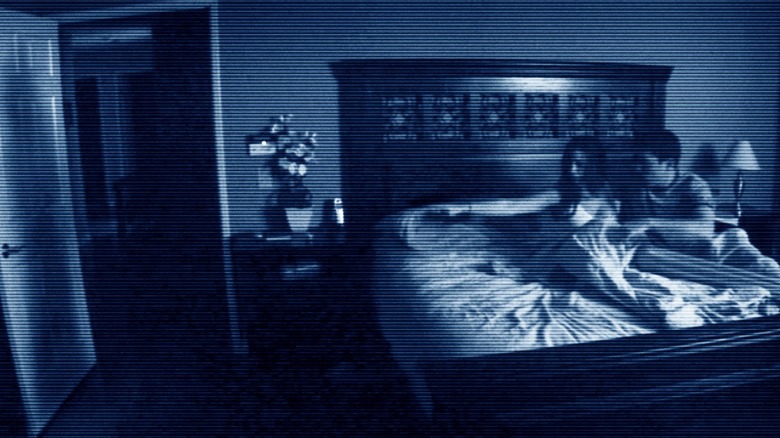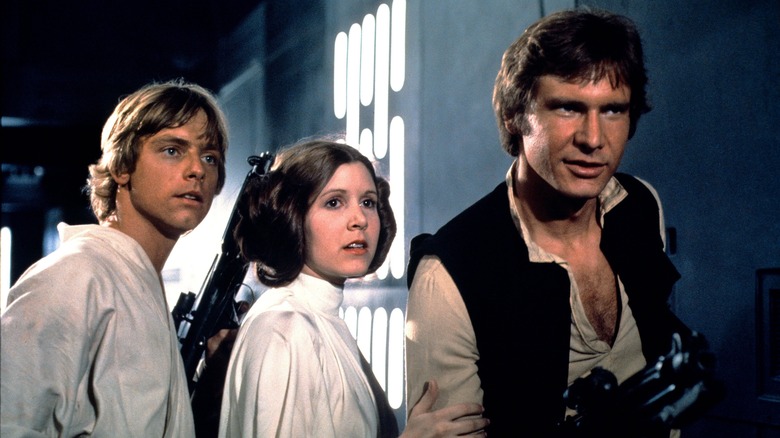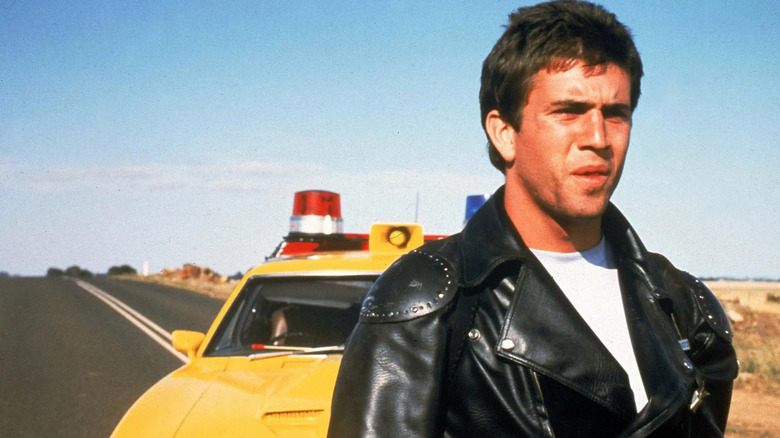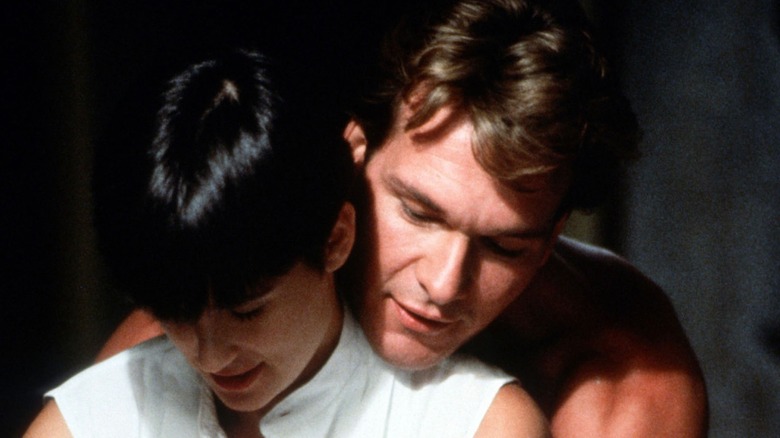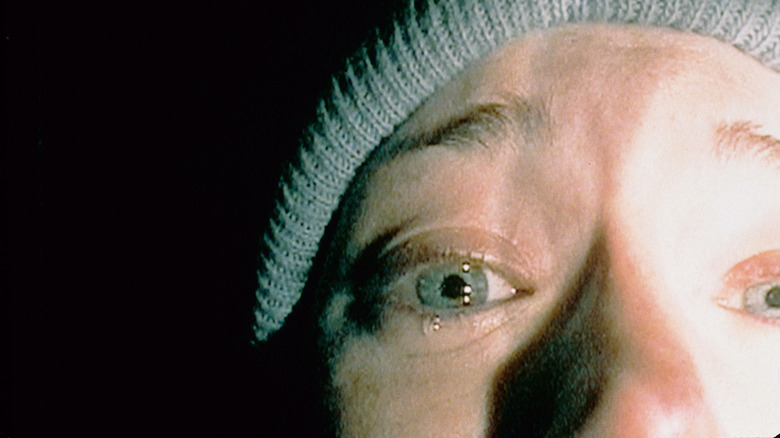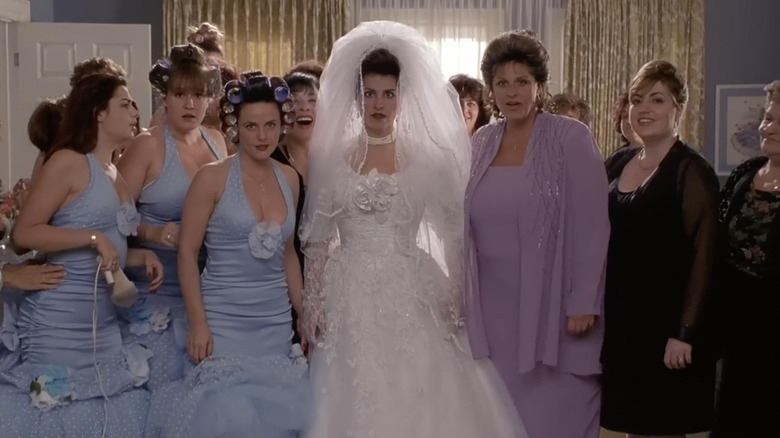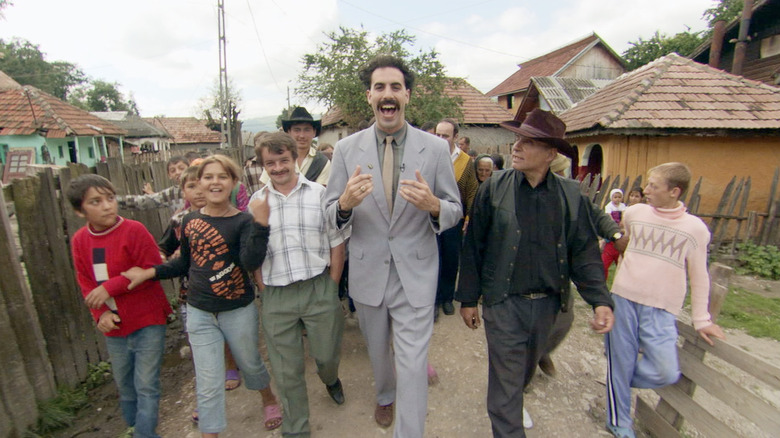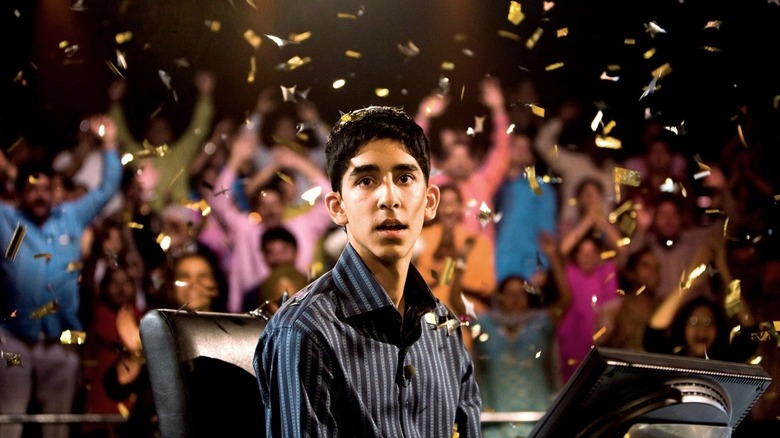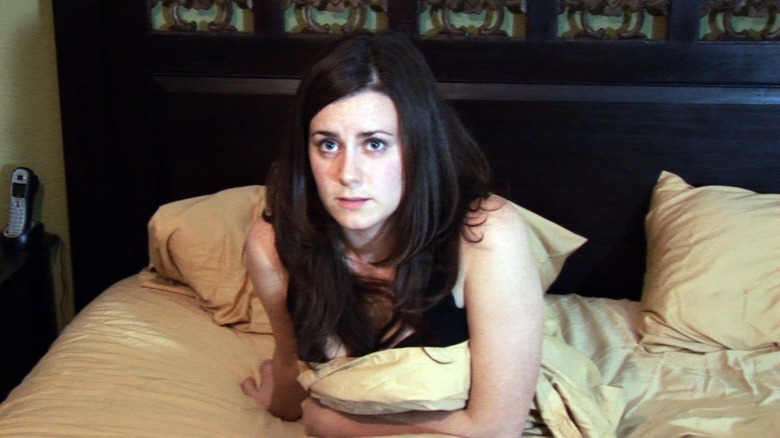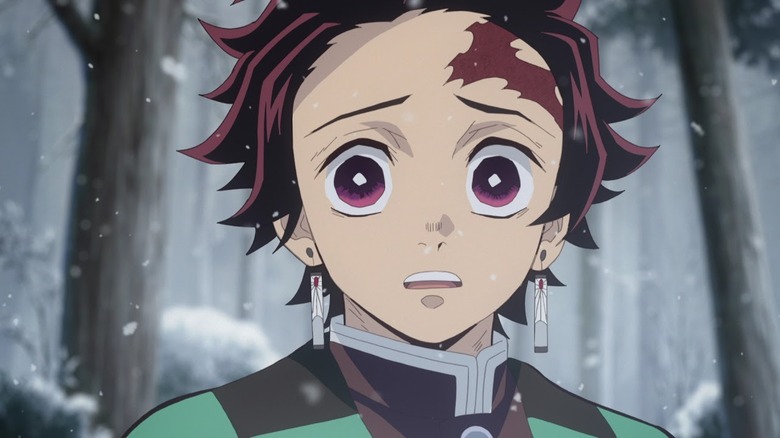10 Of The Most Unexpected Box Office Hits In History
Every single year, there are box office success stories that take us by surprise. 2024 alone has seen several unpredictable hits unfold, from the breakout monster that was "Inside Out 2" to the wildly unlikely $100 million indie horror success "Longlegs." It's not something that happens every day, but when it does, it raises an eyebrow and forces one to look at the movie business just a little bit differently. It's impossible to predict, yet always results in others trying to emulate that same success. As many studios have learned, lightning in a bottle is difficult to capture.
But what are some of the biggest surprises in cinema history? What are the box office hits that truly nobody saw coming? We're not talking about movies that overperformed against expectations. No, we're talking about the movies that truly took the world by storm and, in some cases, changed the course of cinema history in the process. Here's a look at 10 of the biggest box office hits that nobody saw coming, as well as some takeaways from their shocking popularity.
Star Wars (1977)
It may seem a little silly to talk about a franchise as ubiquitous in pop culture as "Star Wars" in the context of this list, but it's easy to forget that one of the most successful ventures in the history of screen media had relatively humble beginnings. Director George Lucas was not a known quantity at the time his now-classic sci-fi epic was in production. Fox had no faith in "Star Wars" and Lucas literally couldn't afford any mistakes because the budget was so tight. Even if we account for inflation, for Lucas to pull off what he pulled off with an $11 million budget is downright astonishing. Let's be clear, though: Everything was working against this movie.
After disastrous test screenings, inventing special effects that had never been pulled off in the history of cinema before, and avoiding having the plug pulled on the project numerous times, Lucas ended up delivering a movie that literally changed the world. That may be true, but it's also true that nobody — not even members of the cast — were convinced that it was going to be a hit. If Fox had thought more of the film, the studio probably wouldn't have given Lucas total control over the merchandising rights.
"Star Wars" (now titled "Star Wars: Episode IV — A New Hope") became a smash hit, the likes of which the world had never seen when it reached theaters in May 1977. The phrase "pop culture phenomenon" doesn't quite cover it. In its original run, the film made more than $307 million. That was truly just the beginning, though. Through its various re-releases, the movie has earned more than $775 million to date. More than that, it has generated untold billions from the sequels, spin-offs, TV shows, theme park attractions, and merchandise over the years. There might be slightly bigger surprises on this list, but there is no bigger outright hit on this list.
Mad Max (1979)
To say that director George Miller's original "Mad Max" is an important film would be an understatement. To say that it is a profitable film would be an even more egregious understatement. Miller's low-budget, high-concept dystopian action flick did an awful lot with very little. Given that it had a budget of less than $1 million and came from an Australian director that nobody had heard of at the time when it arrived in 1979, it was more than an underdog. It seemed like more of a grindhouse, drive-in movie gamble that could turn a quick buck on a minimal investment. Instead, Miller and all involved ended up with one of the most profitable films of all time.
"Mad Max" became a hit all around the world and, despite that minuscule budget, has since earned $100 million worldwide. Even against the most generous estimations of the film's budget — which peg it between $350,000 to $400,000 — that means it has made at least 250 times its budget back over the years. That is truly staggering to consider. It may not be regarded as the best "Mad Max" movie (as that honor unquestionably goes to 2015's "Fury Road"), but it is the most lucrative film in the series by a wide margin.
Ghost (1990)
Find someone who claims that they guessed that director Jerry Zucker's "Ghost" would be the biggest film of 1990 ahead of its release, and you've found yourself a liar. When we talk about things in box office history that were nearly impossible to predict, this is truly a shining example. A romantic thriller about a ghost trying to save the love of his life from those who murdered him? It's a wild concept but, thanks to the one-two punch of Patrick Swayze and Demi Moore, not to mention Whoopi Goldberg at the height of her powers, it resonated with audiences in a big, bad way. It was precisely the right movie at precisely the right time.
"Ghost" was one of those movies that just hung around week after week after week for months on end. It wasn't like modern blockbusters where the opening weekend tells the whole story. To that end, the film opened to $12.1 million before going on to earn $217 million domestically plus $288 million internationally for a ridiculous $505 million global total. It made more than "Pretty Woman," "Home Alone," "Teenage Mutant Ninja Turtles," "Back to the Future Part III," and many other classics released that year. Not bad for a movie with a $22 million budget.
The Blair Witch Project (1999)
When we talk about unexpected hits, 1999's "The Blair Witch Project" may be the textbook definition of such a thing. Before the term found footage even existed to describe this particular subgenre of horror film, directors Eduardo Sánchez and Daniel Myrick scraped together $60,000 to make a compelling, creepy little story that felt like someone's home movie you really shouldn't be watching. It felt dangerous. It was mysterious. There were people that questioned whether it was real or not at a time before you could just look things up on the internet easily. It made for one of the most impressive word-of-mouth hits in cinema history.
The definition of a slow burn, "The Blair Witch Project" opened to just $1.5 million in the summer of '99 before catching on like wildfire in the weeks that followed. This movie that was made for pennies generated true "it must be seen to be believed" buzz that no amount of marketing dollars can purchase. It never topped the charts, but that didn't matter. The film made an astounding $248 million worldwide. Attempts to turn it into a franchise in the years that've followed have been mixed at best, but Lionsgate and Blumhouse are currently making yet another "Blair Witch" movie, which speaks volumes about the original's enduring legacy. More specifically, its legacy as one of the most profitable films ever made, bested only by another horror flick we'll be talking about here shortly.
My Big Fat Greek Wedding (2002)
Rom-coms have been a reliable staple at the box office for decades. Even so, they often only get you so far. They're the equivalent of hitting a single in baseball. Home runs are nice, but getting on base keeps you in the win column. Every once in a while a "You've Got Mail" ($250 million worldwide/$65 million budget) comes along. Then again, not every movie has Tom Hanks and Meg Ryan in it. Remarkably, the biggest success story in the history of the genre is a low-budget affair without an A-list star on its roster. 2002's "My Big Fat Greek Wedding," to this day, is the biggest rom-com in the history of rom-coms, which was truly impossible to see coming.
With a budget of just $5 million and released by the then-fledgling IFC, "My Big Fat Greek Wedding" opened in April of 2002 on just over 100 screens. Over the weeks and months that followed, it became a word-of-mouth smash hit that ended up pulling in an astonishing $241.4 million domestically to go with $133.4 million internationally for a grand total of $374.8 million worldwide. Not only does its raw, global total tower above any other romantic comedy in history, but it made roughly 75 times its budget after playing in theaters for an entire year.
With very little mainstream marketing, star power, or money on its side, what this movie accomplished remains flabbergasting. It's a testament to just how little one can predict what will or won't succeed in theaters. One can try and play the game wisely, but it's a guessing game nonetheless.
Borat (2006)
Sacha Baron Cohen had made a bit of a name for himself in comedy come 2006 thanks to cult favorites like "Da Ali G Show." Be that as it may, nothing about the man's following suggested that his truly wild feature film "Borat" was going to become one of the most acclaimed, financially successful movies of that year. Even now, the fish-out-of-water mockumentary about a TV anchor from Kazakhstan who is sent to report on the United States feels like something that should have been a cult comedy, not unlike "Tenacious D in The Pick of Destiny," which also hit theaters in 2006. Instead, it made more money than all but 14 other movies that year and garnered a Best Adapted Screenplay nomination at the Oscars.
Once word got out about Cohen's on-screen hijinks, the movie practically marketed itself. That led to a remarkable opening weekend for "Borat," with the film pulling in $26.4 million on just 837 screens for a stupefying per-screen average north of $31,000. That sort of thing just doesn't happen. From there, it expanded and it was off to the races, eventually pulling in $128 million domestically and $134 million overseas for a $262 million global total. Cohen became a star, but it's worth remembering that this was his moment. Before this? There was no reason to suspect that he'd be at the center of a film that made more than Adam Sandler's "Click" or the much-beloved Christmas rom-com "The Holiday." As Borat might say, very nice.
Slumdog Millionaire (2008)
Danny Boyle is perhaps one of the most respected directors working today. Before 2008, though, he was more of an indie darling who had relative success with movies like "Trainspotting" and "28 Days Later." His true breakthrough moment came with "Slumdog Millionaire," a movie that not only went on to win Best Picture at the Academy Awards, but also became a true, global smash hit — and an unlikely one at that. It remains Boyle's biggest movie to date by a considerable margin. It also still feels like one of the movies in his catalog least likely to find such mainstream, breakthrough success.
Beyond the fact that Boyle hadn't proven himself as a man capable of delivering a blockbuster at that time, it's also worth remembering that this is a movie about a teenager from the slums of Mumbai who winds up as a contestant on a game show in India. Nothing about that suggested it was going to be a recipe for success. Yet, it became one of the 15 biggest movies of 2008, taking in $378 million worldwide, including $141 million in North America. The critical acclaim led it to awards season glory as well, making it one of the most well-rounded successes of that year. It would have been difficult to predict this particular film would make over $100 million more than "The Incredible Hulk." But that's exactly what happened.
Paranormal Activity (2009)
There are several movies that made more money in terms of raw dollars on this list, but no film in history was more profitable in terms of its return on investment than "Paranormal Activity." Made for just $15,000 (before some reshoots to make the ending more satisfying), "Paranormal Activity" took the found footage genre to new heights a full decade after "The Blair Witch Project" came out. While director Oren Peli's film was originally finished in 2007, it took a full two years before it was released in theaters by Paramount Pictures. It would prove to be well worth the wait; the studio wound up with not just one of the biggest horror hits of the millennium, but also one of the biggest horror franchises of all time.
Like other films on this list, "Paranormal Activity" started slow in late September with a limited release to build buzz. That buzz hit its fever pitch just in time for Halloween, with audiences raving about how scary the film was. It almost became like a challenge of sorts. Can you endure how scary this thing is? Against that made-for-pennies budget, the film topped out at $194 million worldwide, making it the best bang-for-buck investment in Hollywood history. More than that, it spawned a franchise that has since generated $890 million at the global box office against combined production budgets of less than $30 million.
But this isn't a list about profitability. This is a list about unpredictability. Even in the age of YouTube where anyone can get into the filmmaking game with an iPhone and some ingenuity, the odds of a movie this cheap breaking through in such a meaningful way are slim to none. This feels like one in a billion. If anything like it ever happens again, it will be surprising, to say the least.
Wolf Warrior 2 (2017)
This list is heavily-focused on American movies. That's kind of the nature of box office analysis because the list of the biggest movies globally is dominated by American products. That said, China has focused more on homegrown titles in recent years and one of the major turning points in that trend came in 2017 with "Wolf Warrior 2." Directed by Jing Wu, the sequel to 2015's "Wolf Warrior" became perhaps the biggest breakout sequel in cinema history. More than that, it was maybe the biggest point of no return when it came to China prioritizing its own movies rather than shining a spotlight on Hollywood blockbusters.
Even though it made less than $3 million in North America, "Wolf Warrior 2" stands as the 85th biggest movie in history globally, with a massive $870 million to its name, just above "Star Wars: Episode III — Revenge of the Sith." That's particularly impressive given that the first film made less than $100 million in its day. Even more impressive is that $854 million of that money came from China, making it one of the biggest grossers in a single country in cinema history.
In the years since, China has produced other massive hits such as "Hi, Mom" ($822 million), "The Wandering Earth" ($670 million), and "The Battle at Lake Changjin" ($902 million). More than that, it has led to a situation where Hollywood can no longer count on Chinese box office dollars, which was a gigantic part of the business model before the pandemic hit. Focusing on its impact on the global theatrical marketplace, this may well be the most important movie on this list, save for "Star Wars."
Demon Slayer: Kimetsu no Yaiba - The Movie: Mugen Train (2020)
2020 will forever be known as the year that permanently changed the movie business. The pandemic totally shut down the theatrical marketplace for months on end, with some unsure if theaters would ever recover in the aftermath of such devastation. Fortunately, the business has rebounded in some ways, even if the recovery has been slow. But in that terrible, uncertain year, an anime emerged from the depths of tragedy to provide hope. "Demon Slayer: Kimetsu no Yaiba — The Movie: Mugen Train" was by far the most important — and most unlikely — hit of Hollywood's lost year.
Based on the anime series of the same name, director Haruo Sotozaki's "Demon Slayer" film was a huge hit in its native Japan, bringing in $364 million. That's shocking on its own. Even more surprising is that it also broke through in the U.S., pulling in nearly $50 million at a time when no movies were making any money. All told, the film made $453 million worldwide, trailing only China's "The Eight Hundred" ($461 million) globally for the year. For what it's worth, "Bad Boys for Life" ($206.3 million domestic/$426 million worldwide) was the North American champion for 2020.
In any event, the success of "Demon Slayer" was A) almost unthinkable at the time and B) remarkably impactful. In the years since, Hollywood has embraced anime, with films like "Dragon Ball Super: Super Hero" and "The Boy and the Heron," among others, finding mainstream success in American theaters. It's a lasting, meaningful legacy born from the ashes of something terrible. It was, to put a fine point on it, a hit that nobody saw coming.
